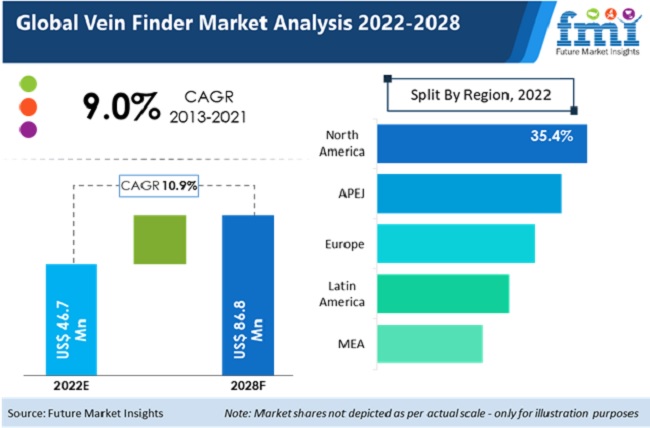Advancements in healthcare technology have fuelled a spate of innovations in medical devices, with top-of-the-line product launches presenting enhanced device functionalities. Innovations in vein finder technology are taking the medical devices sector by storm, with advanced vein finders backed by latest technologies acting as a boon for physicians, nurses, and phlebotomists. The last two years have witnessed notable innovations in vein finder technology, the prominent ones being:
- The world’s first slide style palm vein authentication technology was introduced in the vein finder market by Fujitsu Laboratories Ltd. in 2017. This compact technology is capable of being integrated into tablets and benchtop mobile devices.
- In 2018, Vino Optics launched the Oxy-Iso Paramedic vein glasses, a pair of sunglasses to help physicians and phlebotomists easily locate veins through enhanced image display by filtering ultraviolet rays. This technology is supposedly beneficial for healthcare professionals suffering from colour blindness, as these vein finders help physicians locate veins by enhancing their ability to view reds and greens.
- To Get a Sample Copy of the Report visit @ https://www.futuremarketinsights.com/reports/sample/rep-gb-7640
2013-2021 Vein Finder Market Demand Outlook Compared to 2022-2028 Forecast
Sales of vein finder grew at a CAGR of 9.0% between 2013 and 2021.
The market for vein finder is growing significantly owing to their rising accuracy and reliability in locating veins and is one of the key factors increasing the demand and growth of vein finder market. The development of the market is mainly attributed to technological developments in the healthcare technology that have helped in innovation of new medical devices.
Rising trend of mobile health is likely to boost the adoption of vein finder among healthcare institutions. It is projected that more than 350,000 mHealth apps were available on app stores in 2020. Recently, advanced mobile apps which use sophisticated software to scan the skin of the patients have arrived into the market.
Moreover, in the past few years, the amount of cosmetic surgeries amongst the geriatric population has increased. Surgeries such as facelift, tightening of the skin, body & facial contouring, brow lift, eyelid lift, etc. are very popular. This surge in the number of surgeries increases the demand for vein finder devices.
Considering this, FMI expects the global vein finder market to grow at a CAGR of 10.9% through 2028.

Request Complete TOC Of this Report @ https://www.futuremarketinsights.com/toc/rep-gb-7640
Vein Finder Market Structure Overview: Regional Focus to Bolster Global Market Growth
An overview of the market structure of the global vein finder market reveals a strong regional presence of top market companies as well as local players. Leading companies operating in the global vein finder market are leveraging acquisitions as a primary strategy to facilitate regional market expansion. Future Market Insights analysis also observes a strong focus by vein finder companies on R&D for new product development and expansion of the existing product line in key regional growth markets.
“Implementation of inorganic growth strategies is seen as the way forward to penetrate key growth markets across certain developing regions. Companies in the vein finder market with diversified product offerings are collaborating with local regional players to introduce low-cost vein finder products in order to cement their presence across top regional markets.”
In 2017, the leading three companies in the global vein finder market held a revenue share of about 56% while the remaining players contributed about 44% market share. New product development is a key strategy adopted by players in the global vein finder market to increase their brand value. Rising difficulties associated with peripheral venous access and venepuncture is one of the primary factors boosting growth of the vein finder market and key players are capitalizing on the growth drivers to increase their market share.
Future Market Insights predicts lucrative revenue growth in the various regional markets of Europe and Asia Pacific Excluding Japan. Europe will likely remain the top market for sales of vein finder devices owing to increasing adoption of vein finder across hospitals and clinics to locate veins for drawing blood samples, IV insertions, and other vascular procedures.
Portable Vein Finder to Garner Maximum End User Demand; Infrared Technology to Register Fastest Growth in Revenue, Reveals Future Market Insights
Portable vein finders are likely to be the most preferred product type in the global vein finder market, registering impressive demand as well as sales growth in the coming decade. The convenience and ease of use offered by portable vein finders is the primary factor boosting adoption across hospitals, clinics, and other healthcare institutions. The global vein finder market is fuelled by advanced technology with infrared technology being the most adopted in vein finders. Among the various end users of vein finders, hospitals are likely to exhibit the highest demand in the next 10 years, also contributing to maximum revenues in the global vein finder market.
- Portable
- Benchtop
By Technology:
- Ultraviolet
- Infrared
- Ultrasound
By End User:
- Hospitals
- Clinics
- Ambulatory Surgical Centers
- Diagnostic Centers and Path Labs
- Veterinary Clinics
- Home Care Settings
- Blood Banks
By Region:
- North America
- Latin America
- Europe
- CIS & Russia
- Asia Pacific excluding Japan (APEJ)
- Japan
- Middle East and Africa (MEA)